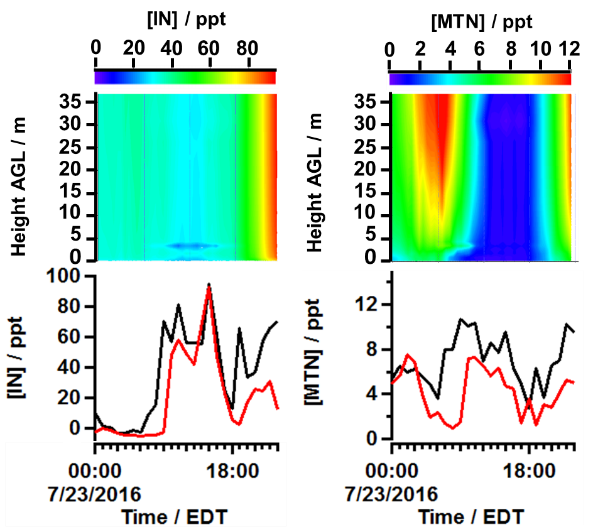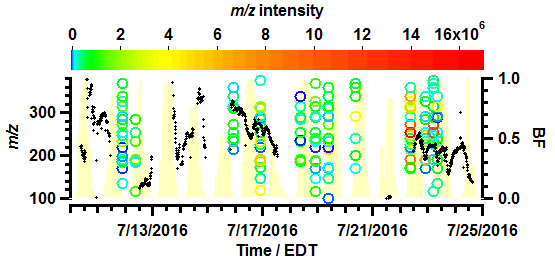Jonathan "Nate" Hall Slade Jr, Ph.D.

Education
Link to CV (PDF)
Ph.D. in Atmospheric Science – State University of New York at Stony Brook, Stony Brook, NY
M.Sc. in Chemistry – Purdue University, West Lafayette, IN
B.Sc. in Chemistry – Winthrop University, Rock Hill, SC
Professional appointments
Postdoctoral Research Associate in Chemistry, Department of Chemistry, Purdue University, 2015-
Research profile
Overview
Jonathan joined the Shepson lab for atmospheric chemistry in 2015 following completion of his doctorate from Stony Brook University under the direction of Dr. Daniel Knopf. His dissertation focused on gas–particle reaction kinetics, specifically the interrelationships between multiphase oxidation kinetics and particle phase state, and how they influence the cloud droplet activation properties of biomass burning aerosol. Since joining the Shepson lab, he has spearheaded new research on the multiphase chemistry of organic nitrates (ON), aimed specifically at understanding the significance of polyolefinic monoterpene oxidation on gas- and particle-phase ON yields and influence on aerosol particle physicochemical properties. His work involves both laboratory chamber and aerosol flow tube studies, organic synthesis, modeling, and field work. His research in the Shepson lab contributes to a better understanding of the ways pollutants interact with biogenic volatile organic compounds (BVOCs) and its climate and air quality effects, and is supported by a three-year National Science Foundation research grant for which he is the Principle Investigator.
Current and Future Work

Current work includes modeling and analyses of isoprene- (IN) and monoterpene-derived hydroxy nitrate (MTN) concentrations measured during the PROPHET-AMOS field study in northern Michigan in July 2016. There, Dr. Slade led a study with graduate student Sarah Desrochers to quantify [IN] and [MTN] near ground (below canopy) and near the canopy top using switchable and heated sampling inlets connected to an iodide-adduct chemical ionization mass spectrometer. To help us mechanistically understand the behavior of IN and MTN below and above the forest canopy, we are collaborating with other groups using zero- and one-dimensional chemistry and canopy flux models. Figure 1 shows preliminary results of modeled (top) and measured IN and MTN vertical gradients. This work will help us to better understand how BVOC oxidation influences the cycling of NOx, radical chemistry, and aerosol formation in forested environments.

Dr. Slade is also investigating the influence of BVOC oxidation chemistry on the phase state of aerosol particles below the mixed forest canopy in northern Michigan. This work involved measurements of particle bounce fractions (BF – proxy for phase state; greater bounce à lower viscosity) and high-resolution particle composition analyses, in collaboration with other PROPHET-AMOS researchers. Figure 2 shows how particle BF (black dots) and molar mass (proxy for phase state) evolve over several days. Compounds with molar masses nearer to 100 are C5- (isoprene) oxidation products, whereas those in the range of 200 to 300 may be associated with C10- (monoterpene) and C15- (sesquiterpene) oxidation products. Preliminary analyses suggest that larger BF corresponds to greater abundance of high molecular weight species and less aerosol liquid water.

We are currently recruiting highly motivated students as part of this research grant to participate in laboratory studies of ON and SOA yields from the OH oxidation of trans-ocimene, a light-dependent monoterpene. This work will follow up on our previous study of ON and SOA yields from γ-terpinene oxidation by NO3. We will also investigate the uptake kinetics and transformations of synthetic ON in the particle phase using an aerosol flow reactor as depicted in the schematic in Fig. 3. Here, the synthesized hydroxy nitrate will be exposed to particles of different acidity and under different relative humidity conditions. The goal of this project is to better understand the uptake and multiphase chemistry of ON, which have been shown to greatly influence the formation of SOA.
Contact: jslade@purdue.edu or pshepson@purdue.edu.
Publications
Slade, J. H., Desrochers, S. J., Harvey, R. M., Bui, A., Bondy, A., Boor, B., Petrucci, G., Ault, A., Griffin, R., and Shepson, P. B. "Contributions of biogenic volatile organic compound oxidation and aerosol liquid water to particle phase state below a mixed forest canopy". In preparation.
Slade, J. H., Desrochers, S. J., Shepson, P. B., et al. "Production, quantification, and vertical gradients of monoterpene-derived hydroxy nitrates within a mixed forest canopy". In preparation.
Desrochers, S. J., Slade, J. H., Shepson, P. B., et al. "Production and quantification of isoprene-derived hydroxy nitrates at and below a mixed forest canopy". In preparation.
Slade, J. H., de Perre, C., Lee, L., and Shepson, P. B. "Nitrate radical oxidation of γ-terpinene: hydroxy nitrate, total organic nitrate, and secondary organic aerosol yields", Atmos. Chem. Phys., 2017. Submitted.
Slade, J. H., Shiraiwa, M., Arangio, A., Su, H., Pöschl, U., Wang, J., and Knopf, D. A. "Cloud droplet activation through oxidation of organic aerosol influenced by temperature and particle phase state", Geophys. Res. Lett., 2017, 44, 1583-1591, doi:10.1002/2016GL072424.
Rindelaub, J. D., Borca, C. H., Hostetler, M. A., Slade, J. H., Lipton, M. A., Slipchenko, L. V., and Shepson, P. B. "The acid-catalyzed hydrolysis of an α-pinene-derived organic nitrate: kinetics, products, reaction mechanisms, and atmospheric impact", Atmos. Chem. Phys., 2016, 16, 15425-15432, doi:10.5194/acp-16-15425-2016.
Slade, J. H., Thalman, R., Wang, J., and Knopf, D. A. "Chemical aging of single and multicomponent biomass burning aerosol surrogate-particles by OH: implications for cloud condensation nucleus activity", Atmos. Chem. Phys., 2015, 15, 10183-10201, doi: 10.5194/acp-15-10183-2015.
Arangio, A. M., Slade, J. H., Berkemeier, T., Pöschl, U., and Knopf, D. A. "Multiphase chemical kinetics of OH radical uptake by molecular organic markers of biomass burning aerosols: humidity and temperature dependence, surface reaction, and bulk diffusion", J. Phys. Chem. A, 2015, doi: 10.1021/jp510489z
Slade, J. H. and Knopf, D. A. "Multiphase OH oxidation kinetics of organic aerosol: the role of particle phase state and relative humidity", Geophys. Res. Lett., 2014, 41, 5297-5306, doi: 10.1002/2014GL060582.
Slade, J. H. and Knopf, D. A. "Heterogeneous OH oxidation of biomass burning organic aerosol surrogate compounds: assessment of volatilisation products and the role of OH concentration on the reactive uptake kinetics", Phys. Chem. Chem. Phys., 2013, 15, 5898-5915, doi: 10.1039/C3CP44695F *recognized as top ten most read papers in PCCP while in press.
Knopf, D. A., Forrester, S. M. and Slade, J. H. "Heterogeneous oxidation kinetics of organic biomass burning aerosol surrogates by O3, NO2, N2O5, and NO3", Phys. Chem. Chem. Phys., 2011, 47, 21050-21062, doi: 10.1039/C1CP22478F.
Slade, J. H., VanReken, T. M., Mwaniki, G. R., Bertman, S., Stirm, B., and Shepson, P. B. "Aerosol production from the surface of the Great Lakes", Geophys. Res. Lett., 2010, 37, L18807, doi: 10.1029/2010GL043852.
Slade, J. H., Ph.D. Dissertation: Chemical aging and cloud condensation nuclei activity of biomass burning aerosol proxies in the presence of OH radicals, January 2015.
Slade, J. H., M.Sc. Thesis: Biogenic aerosol production in the Great Lakes region, December 2009.
Personal life
Jonathan lives in West Lafayette, IN with his wife and their three daughters, Anjali (6), Neha (2), and Hemma (<1).

